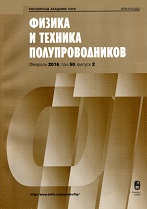|
|
Fizika i Tekhnika Poluprovodnikov, 2016, Volume 50, Issue 3, Pages 302–312
(Mi phts6508)
|
 |
|
 |
This article is cited in 16 scientific papers (total in 16 papers)
Electronic properties of semiconductors
A quasi-classical model of the Hubbard gap in lightly compensated semiconductors
N. A. Poklonskiia, S. A. Vyrkoa, A. I. Kovaleva, A. G. Zabrodskiib
a Belarusian State University, Minsk
b Ioffe Institute, St. Petersburg
Abstract:
A quasi-classical method for calculating the narrowing of the Hubbard gap between the $A^{0}$ and $A^{-}$ acceptor bands in a hole semiconductor or the $D^{0}$ and $D^{-}$ donor bands in an electron semiconductor is suggested. This narrowing gives rise to the phenomenon of a semiconductor transition from the insulator to metal state with an increase in doping level. The major (doping) impurity can be in one of three charge states (–1, 0, or +1), while the compensating impurity can be in states (+1) or (–1). The impurity distribution over the crystal is assumed to be random and the width of Hubbard bands (levels), to be much smaller than the gap between them. It is shown that narrowing of the Hubbard gap is due to the formation of electrically neutral acceptor (donor) states of the quasicontinuous band of allowed energies for holes (electrons) from excited states. This quasicontinuous band merges with the top of the valence band ($v$ band) for acceptors or with the bottom of the conduction band ($c$ band) for donors. In other words, the top of the $v$ band for a $p$-type semiconductor or the bottom of the $c$ band for an $n$-type semiconductor is shifted into the band gap. The value of this shift is determined by the maximum radius of the Bohr orbit of the excited state of an electrically neutral major impurity atom, which is no larger than half the average distance between nearest impurity atoms. As a result of the increasing dopant concentration, the both Hubbard energy levels become shallower and the gap between them narrows. Analytical formulas are derived to describe the thermally activated hopping transition of holes (electrons) between Hubbard bands. The calculated gap narrowing with increasing doping level, which manifests itself in a reduction in the activation energy $\varepsilon_2$ is consistent with available experimental data for lightly compensated $p$-Si crystals doped with boron and $n$-Ge crystals doped with antimony.
Keywords:
Charge State, Impurity Atom, Mott Transition, Impurity Band, Thermal Activation Energy.
Received: 03.08.2015
Accepted: 08.09.2015
Citation:
N. A. Poklonskii, S. A. Vyrko, A. I. Kovalev, A. G. Zabrodskii, “A quasi-classical model of the Hubbard gap in lightly compensated semiconductors”, Fizika i Tekhnika Poluprovodnikov, 50:3 (2016), 302–312; Semiconductors, 50:3 (2016), 299–308
Linking options:
https://www.mathnet.ru/eng/phts6508 https://www.mathnet.ru/eng/phts/v50/i3/p302
|


| Statistics & downloads: |
| Abstract page: | 75 | | Full-text PDF : | 27 |
|





 Contact us:
Contact us: Terms of Use
Terms of Use
 Registration to the website
Registration to the website Logotypes
Logotypes









 Citation in format
Citation in format 